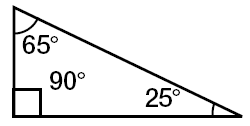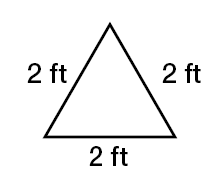Geometry Unit Exam Part 1
.png)
YOU MAY NOT USE A CALCULATOR FOR THIS PART OF THE EXAM!
1) Polygons Shapes 3-10 Types of Triangles Types of Quadrilaterals 2) Transformations Rotations Reflections Translations Dilations 3) Pythagorean Theorem
4) Linear Equations Review
- 1.
Solve for the missing side:
- A.
- B.
- C.
- D.
Correct Answer
C. -
- 2.
Solve for the missing side:
- A.
9
- B.
10
- C.
- D.
Correct Answer
C. -
- 3.
A flag hangs on a pole that is 12 feet tall. The distance between Ms. Schaaf and the top of the flag pole is 15 feet. How far from the bottom of the flag pole does Ms. Schaaf stand?
- A.
9 feet
- B.
10 feet
- C.
11 feet
- D.
12 feet
Correct Answer
A. 9 feetExplanation
Ms. Schaaf stands 9 feet away from the bottom of the flag pole because the distance between her and the top of the flag pole is 15 feet, and the flag pole is 12 feet tall. To find the distance from the bottom of the flag pole, we subtract the height of the flag pole from the total distance, which gives us 15 - 12 = 3 feet. Since Ms. Schaaf is standing above the bottom of the flag pole, we subtract this distance from the total distance, which gives us 3 - 12 = 9 feet.Rate this question:
-
- 4.
Ms. Schaaf is at Everett Middle School. She needs to get to Kezar Stadium to watch the boys soccer game. She could drive west for 4 miles, and then north for 1 mile and arrive at Kezar. How many miles would it be if instead, she drove directly to Kezar (along the hypotenuse of the triangle)?
- A.
~ 4.1 miles
- B.
~ 3.5 miles
- C.
~ 2 miles
- D.
~ 3 miles
Correct Answer
A. ~ 4.1 milesExplanation
If Ms. Schaaf drives west for 4 miles and then north for 1 mile, she would be traveling along the two sides of a right triangle. The distance she would have to drive directly to Kezar Stadium would be the length of the hypotenuse of this triangle. Using the Pythagorean theorem, we can calculate the length of the hypotenuse as the square root of the sum of the squares of the two sides. In this case, the length of the hypotenuse would be approximately 4.1 miles.Rate this question:
-
- 5.
A 15 foot ladder leans up against a wall. The bottom of the ladder is 5 feet from the bottom of the building. Approximately how high up the wall does the ladder reach?
- A.
~14.1 feet
- B.
~ 3 feet
- C.
~ 13.2 feet
- D.
~ 10.1 feet
Correct Answer
A. ~14.1 feetExplanation
The ladder forms a right triangle with the wall and the ground. The length of the ladder is the hypotenuse of the triangle, and the distance from the bottom of the ladder to the bottom of the building is one of the legs. Using the Pythagorean theorem (a^2 + b^2 = c^2), we can calculate the length of the other leg, which represents the height up the wall that the ladder reaches. In this case, the calculation would be 5^2 + b^2 = 15^2. Solving for b, we find that b is approximately 14.1 feet.Rate this question:
-
- 6.
What type of triangle is shown below?
- A.
Acute triangle
- B.
Obtuse triangle
- C.
Right triangle
Correct Answer
C. Right triangleExplanation
Based on the given information, the triangle shown below is a right triangle. A right triangle is a triangle that has one angle equal to 90 degrees.Rate this question:
-
- 7.
What type of triangle is shown below?
- A.
Scalene
- B.
Equilateral
- C.
Isosceles
Correct Answer
B. EquilateralExplanation
The given answer, equilateral, suggests that the triangle shown below is an equilateral triangle. An equilateral triangle is a type of triangle in which all three sides are of equal length. This means that all angles in an equilateral triangle are also equal, measuring 60 degrees each.Rate this question:
-
- 8.
The transformation shown above is a
- A.
Dilation of 1
- B.
Dilation of 2
- C.
Dilation of 1/2
- D.
Dilation of 4
Correct Answer
B. Dilation of 2Explanation
The transformation shown above is a dilation of 2 because all the points on the figure have been expanded or contracted by a scale factor of 2 from the original figure. This means that each point on the figure has been moved twice as far away from or closer to the center of dilation compared to its original position.Rate this question:
-
- 9.
The transformation shown above is a
- A.
Reflection over x-axis
- B.
Reflection over y-axis
- C.
Reflection over x = -2
- D.
Reflection over y = -2
Correct Answer
D. Reflection over y = -2Explanation
The given answer states that the transformation shown is a reflection over the line y = -2. This means that every point on the original figure is reflected across the line y = -2 to create the transformed figure. The line y = -2 acts as the mirror line, with all points on one side of the line being flipped to the other side while maintaining the same distance from the line.Rate this question:
-
- 10.
Describe the rotation that occurred above
- A.
90 degrees clockwise
- B.
180 degrees
- C.
90 degrees counter clockwise
- D.
360 degrees
Correct Answer
C. 90 degrees counter clockwiseExplanation
The rotation that occurred above can be described as a rotation of 90 degrees counter clockwise. This means that the object or shape was rotated in the opposite direction of the clock's movement by an angle of 90 degrees.Rate this question:
-
- 11.
A translation that moves 6 units down and 5 units to the right can be described as
- A.
( x - 6 , y + 5 )
- B.
( x + 6 , y - 5 )
- C.
( x + 5 , y - 6 )
- D.
( x - 5 , y + 6 )
Correct Answer
C. ( x + 5 , y - 6 )Explanation
A translation that moves 6 units down and 5 units to the right can be described as ( x + 5 , y - 6 ). This is because when we move down, the y-coordinate decreases, so we have y - 6. Similarly, when we move to the right, the x-coordinate increases, so we have x + 5.Rate this question:
-
- 12.
A stop sign is shaped like an
- A.
Nonagon
- B.
Octagon
- C.
Heptagon
Correct Answer
B. OctagonExplanation
A stop sign is shaped like an octagon because it has eight sides. The octagon shape is easily recognizable and distinguishes a stop sign from other types of signs. The eight sides provide enough space for the word "STOP" to be clearly displayed in white letters. Additionally, the octagonal shape helps to draw attention and alert drivers to come to a complete stop at intersections.Rate this question:
-
- 13.
A polygon with five sides is called
- A.
Triangle
- B.
Hexagon
- C.
Pentagon
Correct Answer
C. PentagonExplanation
A polygon with five sides is called a pentagon.Rate this question:
-
- 14.
A decagon has
- A.
10 sides
- B.
8 sides
- C.
0 sides
Correct Answer
A. 10 sidesExplanation
A decagon is a polygon with ten sides. This means that it has ten straight line segments that connect to form a closed shape. Each side of a decagon is equal in length and the sum of all its interior angles is equal to 1440 degrees. Therefore, the correct answer is 10 sides.Rate this question:
-
- 15.
Is the point (1,1) on the line y = 2x + 1?
- A.
Yes
- B.
No
- C.
Sometimes
Correct Answer
B. NoExplanation
The point (1,1) is not on the line y = 2x + 1 because when we substitute x = 1 into the equation, we get y = 2(1) + 1 = 3, which is not equal to 1. Therefore, the point (1,1) does not satisfy the equation and is not on the line.Rate this question:
-
- 16.
What is the slope of this line?
- A.
- 1/2
- B.
2
- C.
-2
- D.
1/4
Correct Answer
A. - 1/2Explanation
The slope of a line is a measure of how steep it is. In this case, the slope of the line is -1/2. This means that for every 1 unit increase in the horizontal direction, the line decreases by 1/2 unit in the vertical direction. It has a negative sign because the line is sloping downwards from left to right.Rate this question:
-
- 17.
Describe the following transformation
- A.
( x-7, y-3 )
- B.
( x-10, y+3 )
- C.
( x+7, y-3 )
- D.
( x-3, y-7 )
Correct Answer
A. ( x-7, y-3 )Explanation
The given transformation involves shifting the coordinates of a point by a certain amount. The x-coordinate is shifted 7 units to the right and the y-coordinate is shifted 3 units downwards. This can be observed in all the given options, but the correct answer is (x-7, y-3) because it accurately reflects the direction and magnitude of the shift.Rate this question:
-
- 18.
The following two lines will: y = -2x + 5 y = -2x - 3
- A.
Intersect at one point.
- B.
Will never intersect.
- C.
Intersect at all point.
Correct Answer
B. Will never intersect.Explanation
The two lines have the same slope (-2) but different y-intercepts (5 and -3). This means that the lines are parallel and will never intersect.Rate this question:
-
- 19.
Which is the slope - intercept form of a line?
- A.
M = yx + b
- B.
- C.
Y = mx + b
- D.
Y = bx + m
Correct Answer
C. Y = mx + bExplanation
The slope-intercept form of a line is represented by the equation y = mx + b, where m is the slope of the line and b is the y-intercept. This equation allows us to easily identify the slope and y-intercept of a line by looking at the coefficients of the variables. Therefore, the correct answer is y = mx + b.Rate this question:
-
- 20.
True or false: The equation of the line that goes through the points is y = -3x + 2
- A.
True
- B.
False
Correct Answer
B. FalseExplanation
The equation of the line that goes through the given points is not y = -3x + 2.Rate this question:
-
Quiz Review Timeline +
Our quizzes are rigorously reviewed, monitored and continuously updated by our expert board to maintain accuracy, relevance, and timeliness.
-
Current Version
-
Mar 20, 2023Quiz Edited by
ProProfs Editorial Team -
Mar 18, 2014Quiz Created by
Schaafl
 Back to top
Back to top











.jpg)





.jpeg)

.png)

